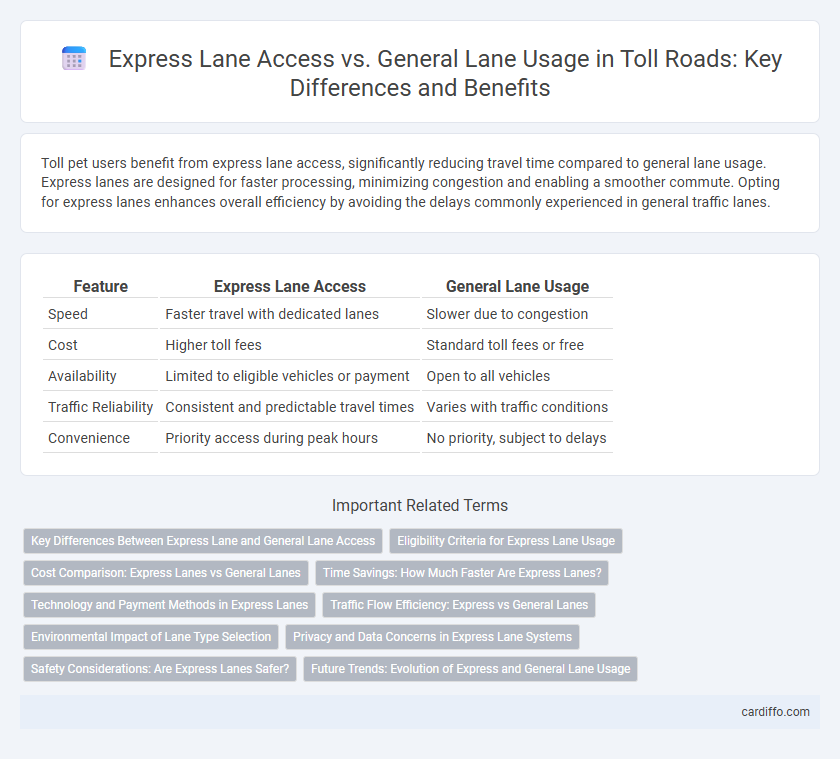Toll pet users benefit from express lane access, significantly reducing travel time compared to general lane usage. Express lanes are designed for faster processing, minimizing congestion and enabling a smoother commute. Opting for express lanes enhances overall efficiency by avoiding the delays commonly experienced in general traffic lanes.
Table of Comparison
| Feature | Express Lane Access | General Lane Usage |
|---|---|---|
| Speed | Faster travel with dedicated lanes | Slower due to congestion |
| Cost | Higher toll fees | Standard toll fees or free |
| Availability | Limited to eligible vehicles or payment | Open to all vehicles |
| Traffic Reliability | Consistent and predictable travel times | Varies with traffic conditions |
| Convenience | Priority access during peak hours | No priority, subject to delays |
Key Differences Between Express Lane and General Lane Access
Express lane access provides faster, dedicated pathways designed to reduce congestion by allowing vehicles to bypass general traffic queues, often requiring toll payments or transponder use. General lane usage operates without access restrictions, accommodating all vehicles but typically experiencing higher traffic volumes and slower speeds during peak times. Key differences include cost structure, traffic flow efficiency, and eligibility criteria, with express lanes prioritizing efficiency through dynamic toll pricing and occupancy requirements.
Eligibility Criteria for Express Lane Usage
Eligibility criteria for express lane access primarily include having a valid transponder or electronic toll collection device linked to an active account with preloaded funds. Certain regions require vehicles to meet specific occupancy thresholds, such as high-occupancy vehicle (HOV) status, to qualify for express lane usage. Compliance with vehicle type and emissions standards is also mandatory in some jurisdictions to maintain eligibility for express lanes.
Cost Comparison: Express Lanes vs General Lanes
Express lanes typically charge dynamic toll rates based on real-time traffic conditions, resulting in higher but often faster and more reliable travel costs. General lanes are toll-free or have fixed, lower tolls but frequently experience congestion that increases travel time and fuel expenses. Comparing costs requires factoring in both toll fees and time savings, with express lanes offering value primarily through reduced delays and improved predictability.
Time Savings: How Much Faster Are Express Lanes?
Express lanes typically reduce travel time by 15-40% compared to general lanes, depending on traffic conditions and time of day. These lanes use dynamic pricing to manage congestion, encouraging faster flow and shorter wait times for paid users. Studies show average speed in express lanes can reach 55-65 mph while general lanes often slow to 25-40 mph during peak hours.
Technology and Payment Methods in Express Lanes
Express lanes utilize advanced RFID and automatic number plate recognition technologies to enable seamless vehicle identification and toll collection. Payment methods in express lanes often include prepaid electronic toll accounts, mobile apps, and contactless credit or debit card options, minimizing transaction times. These technologies reduce congestion by allowing vehicles to maintain highway speeds without stopping at toll booths.
Traffic Flow Efficiency: Express vs General Lanes
Express lanes significantly improve traffic flow efficiency by reducing congestion and travel time for vehicles willing to pay tolls. General lanes often experience slower speeds and higher vehicle density due to unrestricted access and volume. By managing demand through dynamic pricing, express lanes optimize roadway capacity and enhance overall traffic throughput.
Environmental Impact of Lane Type Selection
Express lane access reduces overall vehicle emissions by minimizing stop-and-go traffic and congestion compared to general lanes. Vehicles in general lanes experience longer idling times, contributing to increased fuel consumption and elevated carbon dioxide output. Choosing express lanes supports environmental sustainability by promoting smoother traffic flow and lowering greenhouse gas emissions.
Privacy and Data Concerns in Express Lane Systems
Express lane systems collect extensive vehicle and driver data through transponders and cameras, raising significant privacy concerns over continuous location tracking and data sharing with third parties. Unlike general lanes, which often involve manual toll payments without persistent data capture, express lanes require digital profiles that could be vulnerable to hacking or unauthorized surveillance. Users must weigh the convenience of faster travel against potential risks of personal data exposure and long-term retention by toll agencies or contractors.
Safety Considerations: Are Express Lanes Safer?
Express lanes typically enhance safety by reducing congestion and minimizing lane changes, which lowers the risk of collisions compared to general lanes. These lanes often feature controlled access points and fewer entries and exits, contributing to smoother traffic flow and fewer conflict zones. Data from transportation studies indicate that express lanes experience fewer accidents per mile, making them a safer option for commuters.
Future Trends: Evolution of Express and General Lane Usage
Future trends indicate a growing shift towards express lane access due to advancements in electronic toll collection and dynamic pricing models, enhancing traffic flow and reducing congestion in urban areas. General lane usage may decline as smart infrastructure integrates real-time data analytics to optimize lane allocation based on traffic demand patterns. Increased adoption of connected vehicle technology will further accelerate the evolution, enabling seamless transitions between express and general lanes while maximizing roadway efficiency.
Express lane access vs General lane usage Infographic

 cardiffo.com
cardiffo.com